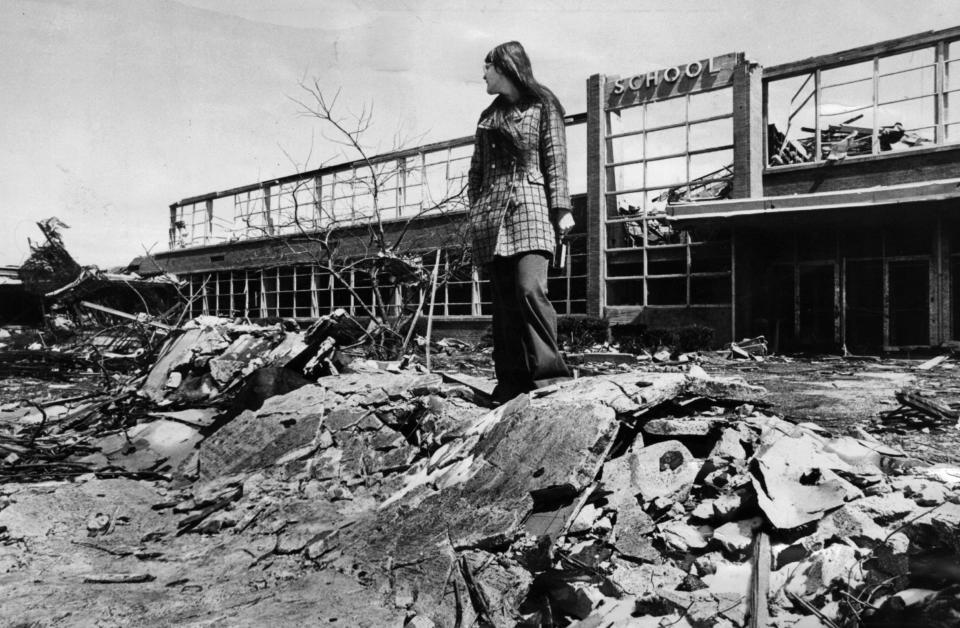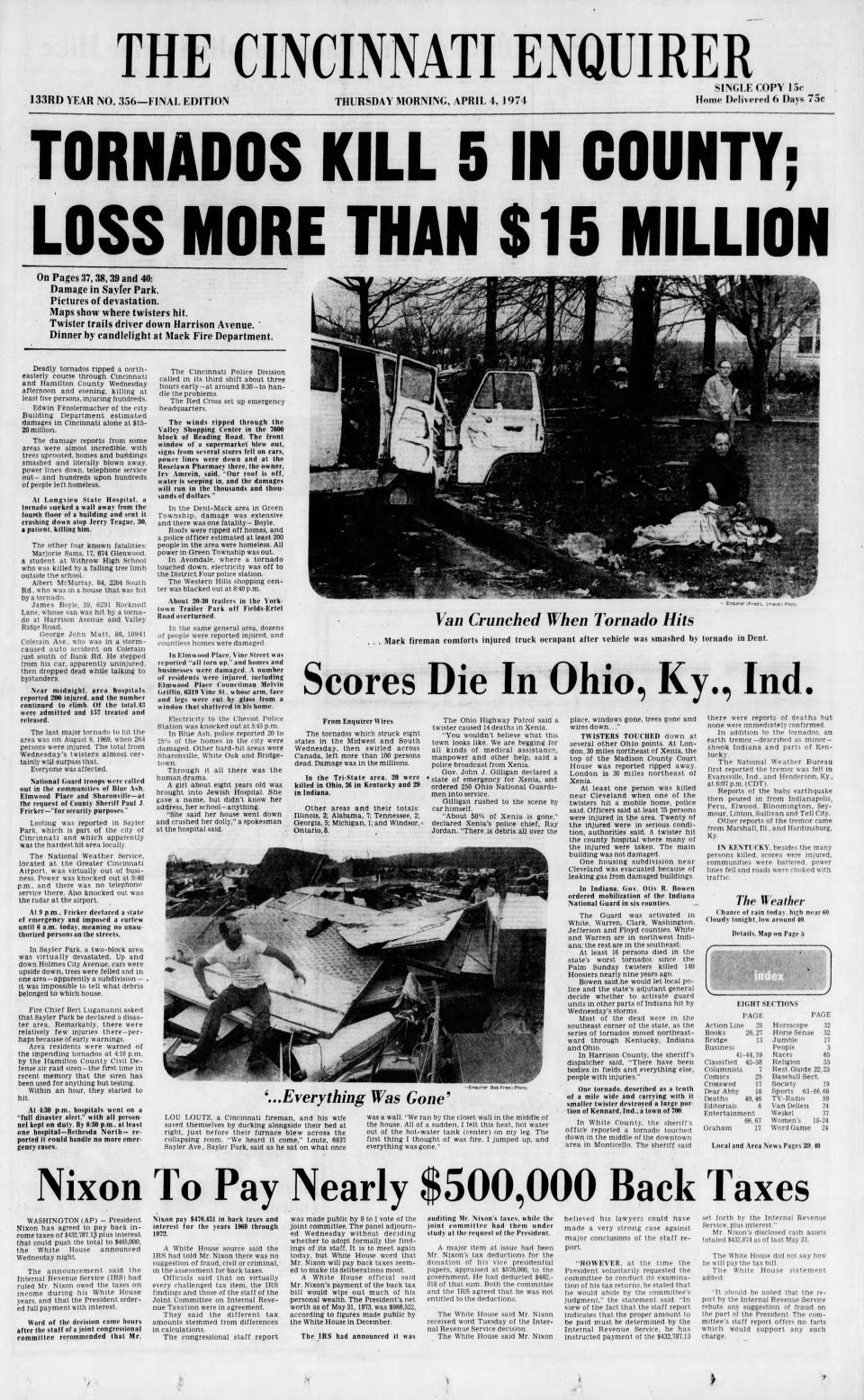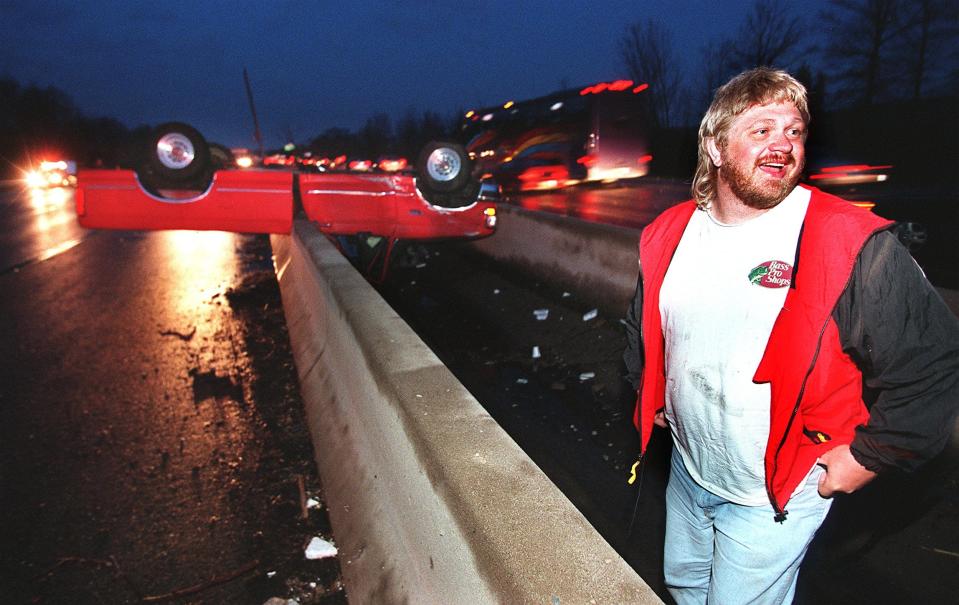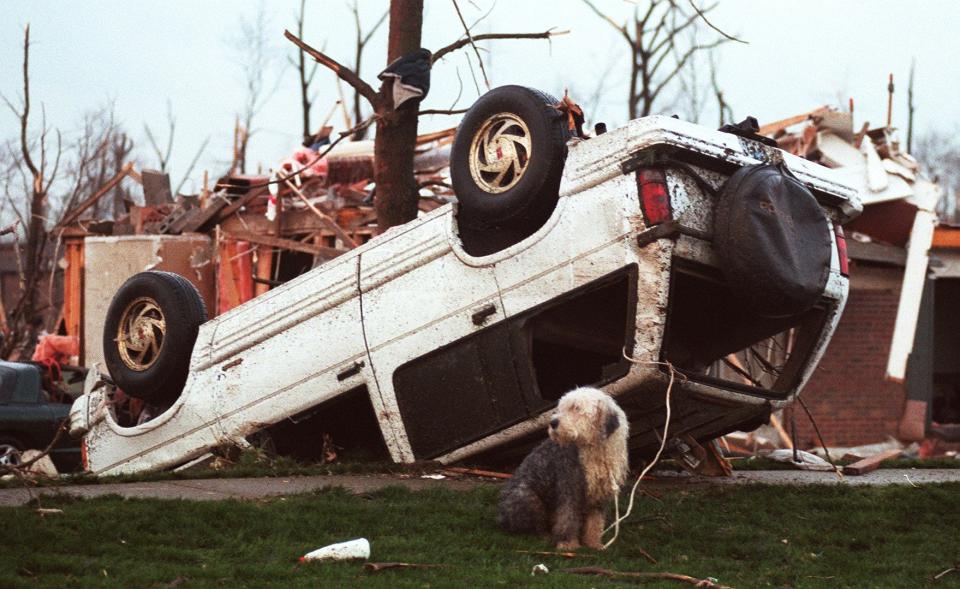How the catastrophic Xenia, Blue Ash tornadoes brought chaos to Ohio
The severe weather this past week served as a reminder of our sometimes volatile relationship with Mother Nature. People pay close attention to dark gray skies this time of year.
Tornado season in Ohio typically runs from April through June, but the fiercest storms always seem to arrive here in early April. In less than a week’s time, we mark two anniversaries of the deadliest tornadoes to hit the region, 25 years apart.
Fifty years ago, on April 3, 1974, a “Super Outbreak” hit the Midwest. Over a 24-hour period, a total of 148 tornadoes touched down across 13 states in a swath from Alabama to Ontario, Canada. There were 335 people killed, with 179 of the fatalities in Ohio, Kentucky and Indiana.
The harshest of those twisters struck Xenia, Ohio, a small city of 25,000 about 15 miles east of Dayton. The name Xenia would be forever associated with that tragic day.
A quarter of a century later, another deadly tornado touched down in Montgomery and Blue Ash in suburban Cincinnati. A quarter of a century after that, these dark days are still with us.
1974 tornado outbreak: Half of Xenia was gone
It was a warm spring afternoon. School was over for the day and soon the workday would be done, too. Families were setting the table for supper. Then the sky grew ominous, charcoal clouds with a greenish hue.
Most people didn’t know what was coming their way.
Xenia didn’t have any tornado sirens at that time. And weather detecting technology was primitive by today’s standards. Doppler radar wasn’t yet widely used – this tornado outbreak would change that. There were none of the early warning signs we have now. No cell phones with news alerts pinging in our pockets.
At 4:07 p.m., the National Weather Service radar at the Cincinnati/Northern Kentucky International Airport spotted a “possible tornado,” with its signature hook-shaped image on the radar screen.
At 4:30 p.m., WLW-D meteorologist Bob Breck interrupted programming to broadcast a tornado warning on Channel 2 in Dayton. He was the first to warn the public.
Ten minutes later, a tornado ravaged Xenia. The funnel tore through downtown and wiped out the 200 homes of the Arrowhead subdivision. Then it hit Wilberforce and Cedarville.
The tornado was rated an F5, which is the highest measure on the Fujita scale of damage. It whipped up 300 mph winds that shredded hundreds of homes and business buildings. In Xenia alone, 32 people were killed, 1,000 were injured and thousands were homeless.
“About 50% of Xenia is gone,” Xenia police chief Ray Jordan declared that day. “There is debris all over the place, windows gone, trees gone and wires down …”

Xenia High School was reduced to rubble. Some school buses were picked up by the wind and hurled three blocks. The clocks were stuck at 4:40 p.m. Thankfully, the schools were already empty by that time.
Debris from Xenia was found as far as 200 miles from the city. A Penn Central train was derailed across Main Street, impeding relief efforts from the Ohio National Guard.
In anniversary coverage five years ago, NBC4 meteorologist Ben Gelber in Columbus summed up the historic tornado: “It was just an unthinkable storm in terms of size, magnitude and tragedy.”
And that wasn’t the only tornado to hit Southwest Ohio that day.
Second tornado hit Sayler Park and Northern Kentucky
Another F5 tornado clobbered Sayler Park on Cincinnati’s west side, along the river.
A two-block area of Holmes Avenue was devastated. “Cars were upside down, trees were felled and it was impossible to tell what debris belonged to which house,” The Enquirer reported.

One man said it was like the bomb raids he experienced in the military.
A Sayler Park woman described her experience with the twister: “I was walking down the stairs when it happened. The lights went out and then it just went ‘woosh.’ The roof and insulation and glass all flew into the courtyard. I didn’t do anything. I just stood there saying, ‘Oh my goodness. Oh my goodness.’ It was over in a flash.”
A Covington patrolman saw a V-shaped cloud zipping back and forth across the Ohio River. Power and telephone lines were knocked out at the weather service office at CVG, so there were no updated reports.
Hebron in Boone County was hit hard. As was Dent and other parts of Green Township, plus Roselawn, Mason and Blue Ash. There were five deaths in Hamilton County.
Picking up the pieces
President Richard Nixon visited Xenia a few days later and was surprised by the level of damage. He pledged that federal aid would be coming.
Nixon later cited Xenia as an example to Congress of the need to pass the Disaster Relief Act of 1974.
Despite the devastation and upheaval, the world kept turning.
Cincinnati Reds’ Opening Day at Riverfront Stadium took place the day after the tornadoes.
“It seemed so soon to be playing games again,” Enquirer sports columnist Tom Callahan wrote. “Not even a full day had gone by. That’s hardly enough time to cry.
“Shouldn’t there be more lull after storms like Wednesdays?”
In the first inning, Hank Aaron of the Atlanta Braves belted his 714th home run to match the all-time record held by Babe Ruth. Pete Rose, who grew up in Sayler Park, which had just been smashed by a tornado, scored the winning run.
Then, neighbors helped neighbors. Xenia rebuilt. As did Sayler Park, Hebron and elsewhere. The communities survived, but never forgot.
A tornado hit Montgomery and Blue Ash in 1999
Six days after the 25th anniversary of those tornadoes, Cincinnati was forced into a sequel.
Shortly before 5:30 a.m. on April 9, 1999, an F4 tornado broadsided Montgomery and Blue Ash. Winds topping 260 miles per hour destroyed more than 200 homes and businesses. Four people were killed.
Tornado sirens did go off, but it was so early in the morning that many people slept through them.
Donald Busch Jr. was driving southbound on I-71 heading to work that Friday morning. “I saw a couple of bright flashes. Two big balls of blue,” he said. “I guess they were transformers blowing. The rain was picking up. You couldn’t see anything. It was like driving in a cloud.”
Then, “It was like the truck took control of itself.”
The wind lifted his truck and set it upside down on a concrete barrier in the freeway median. Enquirer photographer Craig Ruttle, heading out to photograph the devastation, came across the flipped-over truck and stopped. He found Busch sitting nearby.
“I’m definitely feeling lucky. I never heard it coming,” Busch said.

Another driver in a wreck across the interstate wasn't as fortunate. He was ejected from his car when it was blown into some trees. He was pronounced dead at the scene.
“No matter how many times you’ve seen something like this you still are shocked by the ferocity and how quickly these things take place,” Ruttle told The Enquirer. “It’s just minutes from total normalcy to total chaos. The damage didn’t really become clear to me until the light came up.”
Trees were snapped like matchsticks. Those that were not uprooted were stripped of their bark. Houses lost roofs and walls collapsed. Mattresses and insulation fluff hung from branches.
A couple, Lee and Jacqueline Cook, were asleep in their second-story bedroom when high winds hit their home on Cornell Road. Their bodies were found in a field across the street.

A photograph of their Old English sheepdog tied to an overturned Chevrolet Blazer appeared in the newspaper. A veterinarian recognized the dog, Blarney, and offered to take him in. He was suffering from a fractured pelvis. And a broken heart.
So was the rest of the community. All that was left was picking up the pieces.
Sources: Enquirer, Cincinnati Post, Dayton Daily News archives; National Weather Service; Cincinnati Magazine, “When the clocks stopped around 4:40” by Jeff Louderback
This article originally appeared on Cincinnati Enquirer: How the 1974 Xenia tornado brought chaos to Ohio

